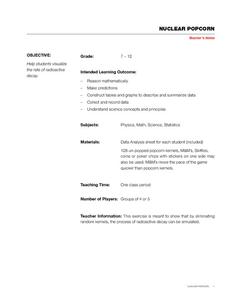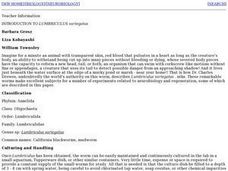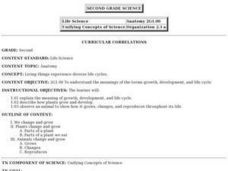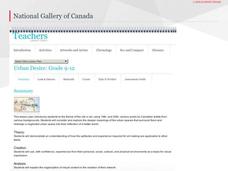Curated OER
Life In Space: The International Space Station
Students learn about the International Space Station. In this space instructional activity, students learn about the structure, operations, and experiments that go on in the International Space Station.
Curated OER
The Planets in Our Solar System
Students gain knowledge about earth and space science by studying the nine planets in the solar system as well as their key characteristics. In this solar system instructional activity, students identify the nine planets. Students work...
Curated OER
Make a Sundial
Pupils explore space science by conducting a sun experiment in class. In this time telling lesson, students discuss how the sun sits in our sky at exact times each day and how astronomy is based on our perspective of the solar system....
National Museum of Nuclear Science & History
Nuclear Popcorn
Make your lesson on radioactive decay pop with this lab exercise. Using popcorn kernels spread over a tabletop, participants pick up all of those that point toward the back of the room, that is, those that represent decayed atoms. As the...
Curated OER
Voyage: A Journey Through Our Solar System
Thoroughly written, this plan walks you through every detail of having your high school astronomers design scale models of the solar system. Complete instructions on building to scale, lesson plan procedures, and associated worksheets...
Curated OER
Introduction to Lumbriculus variegatus
Students conduct two set experiments on Lumbriculus worms and create a third experiment of their own. The first of the two set experiments allows students to observe regeneration of the worms while the second allows students to test the...
Curated OER
Baking Ice Cream
Students discover the concept of an insulator. In this science experiment lesson, students follow the directions for baking ice cream. When baking is completed, students observe the results and answer questions on the provided worksheet.
Curated OER
Science-Unit on Matter-Gases
First graders understand that gases take up space even though you can't see or smell it. This is done through many experiments like trapping air in different sized bags, using balloons and plastic bottles, and blowing bubbles. They...
Curated OER
Interactions of Science and Technologies
Students explore how science and technology interact. They discuss important inventions, discoveries and technologies. They research a specific technological advance, or invention, and prepare a presentation that includes the...
Curated OER
Historic Earth Science Innovations
Young scholars research the demands or limitations on Earth scientists. In groups, they design and build a model that would be useful to them in the lab or field. They share their model and their ideas behind it to the class and answer...
Curated OER
Living Things Experience Diverse Life Cycles
Second graders will study and explain the meaning of growth, development, and life cycle. They describe how plants grow and develop and observe an animal to show how it grows, changes, and reproduces throughout its life.
Curated OER
A Journey Through Our Solar System
Students investigate the concept of the solar system in our universe by constructing a model that is made to a measurable scale. Once the model is constructed it should be placed in a wide open space for observation and demonstration...
Curated OER
Discover Magazine: The Solar System
High schoolers research ideas for NASA's space exploration. In this Space Science lesson plan, students will try to find a way to bring NASA back into the spot light. High schoolers will presented their ideas to the class for review.
Curated OER
The Solar System
Students examine the solar space program and research what options are the most viable. In this solar system lesson students view a video on the solar system, research the Internet and make recommendations.
Curated OER
Earth, Sun and Moon
Students investigate that the sun is at the center of the solar system through role play. One student is the sun and one student is the Earth. The students then show how the Earth orbits around the sun. Students view a flashlight and...
Curated OER
I'm Gone
Students plan a mock mission to Mars. In this space science lesson, students work in cooperative groups and select one experiment to take on their mock mission. Students create a mission plan form and send a proposed experiment to NASA.
Space Awareness
Oceans as a Heat Reservoir
Oceans absorb half of the carbon dioxide and 80 percent of the greenhouse gases released into the atmosphere. Scholars learn how and why the oceans store heat more effectively than land and how they help mitigate global warming. Pupils...
Journey Through the Universe
Our Solar System
Take your class on a journey through our solar system. Learners explore each planet, from Mercury to Pluto, and discuss various features that differentiate one from another. They complete activities related to the topics and discuss the...
National Gallery of Canada
Urban Desire
Urban spaces are often overlooked and broken down. Offer your pupils the opportunity to reimagine an urban space. Learners examine and discuss works of art related to this theme and consider their own communities. Small groups then...
University of Wisconsin
Infiltration Test: Exploring the Flow of Water Through Soils
Soil scientists gain experience with an infiltrometer can to determine the infiltration rates at different locations on campus. If you are using the entire unit, the class has already analyzed water flow and soil types, so they should...
PHET
Planet Designer: Kelvin Climb
It's time to get those creative juices flowing! This second lesson in a series of five continues allowing pupils to design their own planets. It the same format as the first, but, this time, allows students to alter greenhouse gases...
Monroe City Schools
Clouds! Clouds! Clouds!
Here is a beautiful instructional activity on clouds designed for your 1st graders. Learners study three different types of clouds. They construct drawings of cumulus, cirrus, and stratus clouds. The Cloud Book, by Tommie dePaola is...
Rainforest Alliance
Knowing the Essential Elements of a Habitat
To gain insight into the many different types of habitats, individuals must first get to know their own. Here, scholars explore their school environment, draw a map, compare and contrast their surroundings to larger ones. They then...
Chicago Botanic Garden
The Carbon Cycle
There is 30 percent more carbon in the atmosphere today than there was 150 years ago. The first lesson in the four-part series teaches classes about the carbon cycle. Over two to three days, classes make a model of the cycle,...























